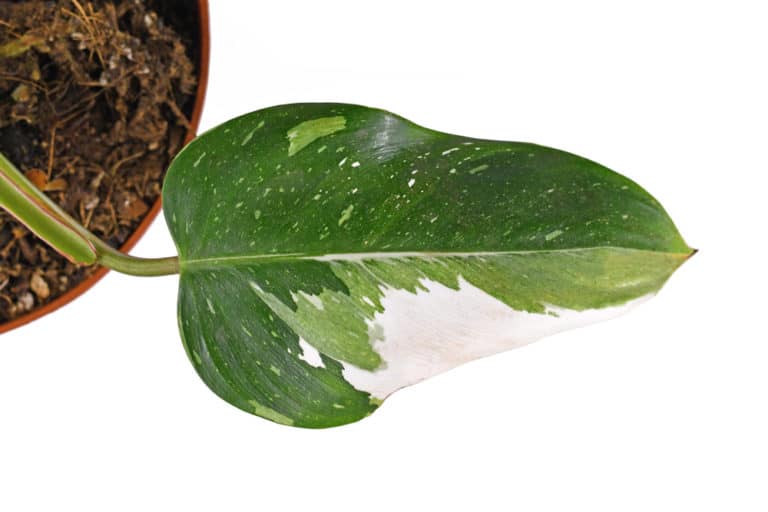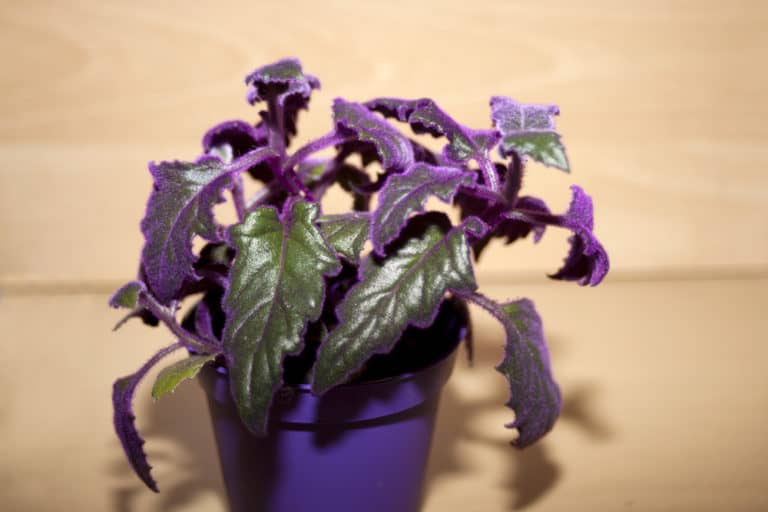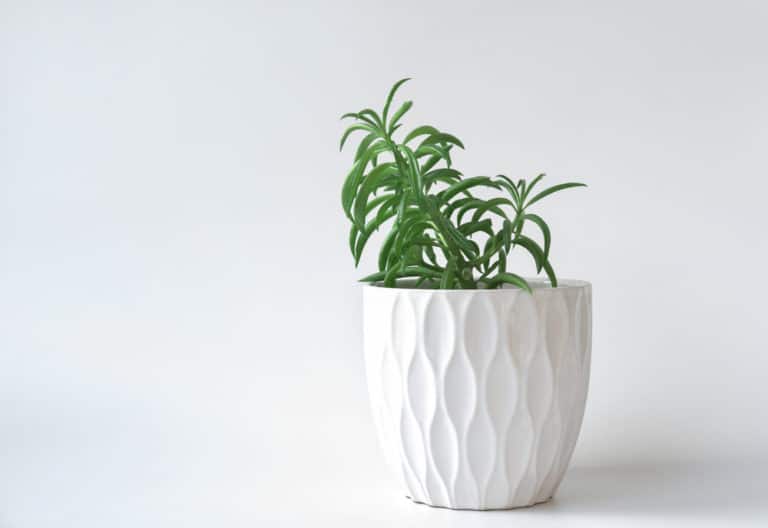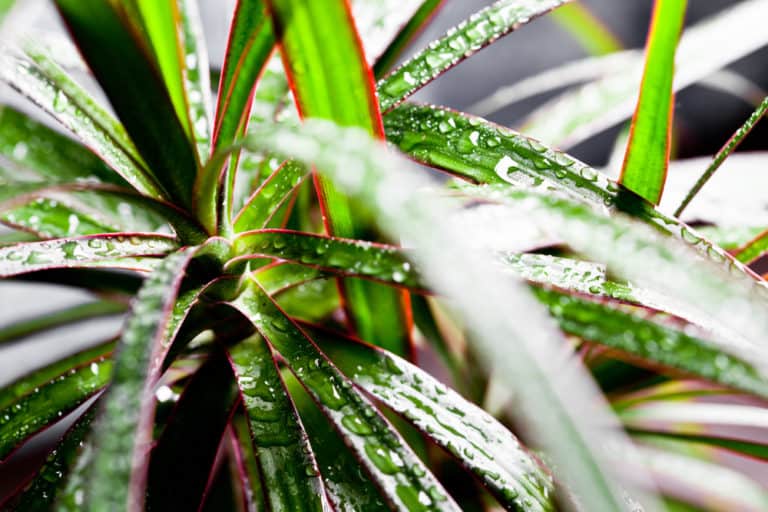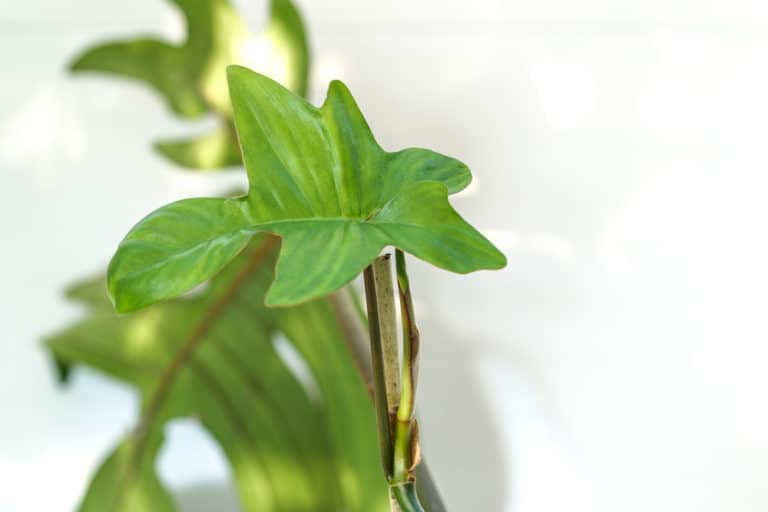Pilea Mollis ‘Moon Valley’ Care Guide (2024)
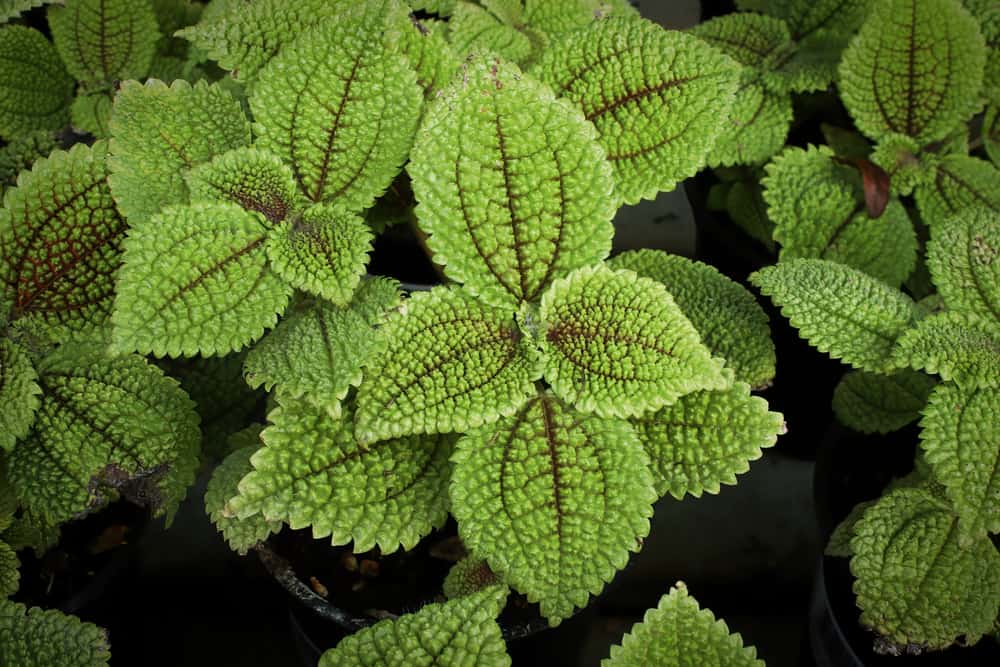
Pilea mollis is a charming little plant that will fit into even the smallest space with room to spare.
Also known as the moon valley friendship plant, its charmingly dimpled leaves have a unique texture and fresh color.
If you can provide it with the warm, humid environment that it craves, this little beauty will make a great addition to your indoor garden.
| Scientific Name | Pilea involucrata ‘Moon Valley’ |
| Common Name | Pilea Mollis, Moon Valley Pilea, Friendship Plant |
| Light | Bright indirect sunlight |
| Watering | Water if the top inch of soil is dry |
| Temperature | 65 to 80ºF (18 to 27ºC) |
| Hardiness Zone | 11 to 12 |
| Humidity | Above 50% |
| Soil Type | Rich, quick-draining, loamy |
| Soil pH | 5 to 6 (acidic) |
| Fertilizing | A balanced feed once every 3 months in spring and summer |
| Repotting | Every 2 years |
| Pruning | During the growing season |
| Propagation | Root in water or soil |
| Toxicity | Not toxic to humans and pets |
| Mature Size | 12 inches as a houseplant |
| Bloom Time | Late spring, early summer |
What’s Unique About Pilea mollis?
The Pilea mollis plant was first identified in 1856, when it was found growing in the tropical rainforests of Colombia and Venezuela.
Since then, Pilea mollis plants have become a popular houseplant.
Because its leaves have a unique, deeply dimpled texture reminiscent of the surface of the moon, it has been given the nickname Moon Valley Pilea.
Growing Pilea mollis isn’t very challenging if you can provide it with the warm and humid microclimate that it needs to thrive.
And unlike so many tropical plants, Pilea mollis is completely non-toxic. This makes it a safe choice for homes with children or pets.
Pilea mollis Care
Since the Moon Valley Pilea is native to the tropical rainforests of South America, you should try to provide it with similar conditions.
The essential elements of Pilea mollis plant care are moist soil, warm temperatures, and as high humidity as you can manage.
If you can supply this Moon Valley Pilea care, your little tropical beauty should thrive.
Light
In the tropical rainforests where Pilea mollis originates, this small plant grows on the forest floor, where the bright tropical sun is filtered by the tree canopy.
In your home, Pilea mollis light requirements are for bright but indirect light, or between 10,000 to 20,000 lux.
You can usually manage your Moon Valley Pilea light needs without supplementary lighting.
Since full sun can severely damage its delicate leaves, an east or north window is best for your Pilea mollis.
If you must keep it in a south-facing room, keep it well away from the direct sun, or shade it with a light curtain.
Watering
In its native tropical rainforest, Pilea mollis grows in the moist, springy soil on the forest floor.
Its watering needs are for consistently moist soil, without it ever being sopping wet.
You need to reach a happy balance between too dry and too wet in your Pilea mollis watering.
The best practice is to water Moon Valley Pilea whenever the top inch of the soil has dried out.
Don’t flood the pot with water, but rather pour a small amount slowly over the surface and let it get absorbed.
When you see water trickling out the bottom, you’ve added enough.
Never leave the pot sitting in water.
Temperature
As it’s used to the hot tropical climate, you should keep your Pilea mollis as warm as possible.
The Pilea mollis temperature range is 65 to 80ºF (18 to 27ºC).
You should easily be able to provide an adequate temperature for Moon Valley Pilea in any heated building.
However, be aware that Pilea mollis has little temperature tolerance below 55ºF (12ºC). Keep it away from drafts and cold windows in winter, or air conditioners in hot weather.
While you may move your Pilea mollis outdoors in the hot humid summer weather, make sure you bring it back inside long before cooler temperatures move in. This tender tropical plant has no frost hardiness at all.
Humidity
In a nutshell, the Pilea mollis humidity requirements are as high as possible.
While the ideal humidity for Moon Valley Pilea can be as high as 80%, you should be able to keep your Pilea mollis happy with a humidity level of 50%.
That’s still fairly high for a heated home, so you will probably have to work on a moister atmosphere for your Pilea mollis.
Start by grouping your tropical plants together, which can help create a microclimate with higher humidity.
You may need to help it out by using a small humidifier in their midst.
Pilea mollis is also a good candidate for terrarium growing because of its small size.
Soil
Pilea mollis soil needs to be able to retain moisture, while at the same time draining excess water, as Pilea mollis is likely to develop root rot in soggy soil.
You should aim for a 5 to 6 pH level for Moon Valley Pilea. That’s moderately acidic.
A good soil for Moon Valley Pilea is African Violet soil, which you can use straight from the bag.
You can also make a custom soil mix with mostly peat moss mixed with well-rotted compost or worm castings and perlite.
Otherwise, just add a good handful of perlite to a standard indoor plant potting mix.
Fertilizer
You do not need to use a lot of fertilizer for Moon Valley Pilea, but extra nutrients will help maintain healthy leaf growth.
You can use a liquid fertilizer formulation with a balanced fertilizer ratio of 10-10-10, or one with a 3-1-2 ratio.
You should apply Pilea mollis fertilizer in early spring, and then again at the beginning of summer.
Dilute the liquid fertilizer to half its recommended strength, and slowly pour it over the soil surface to ensure even absorption.
Always add fertilizer to the soil soon after you’ve watered your Pilea mollis, when the top is still moist.
Potting & Repotting
Pilea mollis repotting should be done every two years, or sooner if the roots are outgrowing its current pot.
Even if the plant has reached its full size, repotting Moon Valley Pilea every couple of years gives you an opportunity to refresh the potting soil.
You will probably also be able to take some root divisions to propagate new plants.
If your Pilea mollis has become rootbound, don’t make the mistake of moving it into too large a pot. Only go up one pot size, or at most 2 inches.
A plastic or glazed pot will help conserve the soil moisture, but make sure it’s got a drainage hole.
Pruning
There is very little need for Pilea mollis pruning.
You may, however, pinch back growing tips to keep a compact shape. While that’s easily done just using your fingers, you can also use sharp, sterilized scissors to make cleaner cuts.
This pruning should be done during the growing season.
You do need to trim off dead or damaged leaves, as they mar the appearance of your Pilea mollis, and can harbor pests or disease. Do this whenever they occur throughout the year.
When cutting Moon Valley Pilea to remove yellowed leaves and stems, always cut into healthy green stems below the damaged sections.
Propagation
There are two very easy ways to propagate Moon Valley Pilea.
The easiest method of Pilea mollis propagation is to divide the roots when you are repotting.
When you pull the root ball out of its pot, you should see baby plants (or pups) growing around the mother plant.
Simply tug them off, making sure that each division has both roots and stems.
Stem cuttings are easy to root, as well. Cut 3 inch lengths of stems, each with at least 2 nodes and a couple of leaves.
Strip all but the top leaves off, and either stick the cuttings into a jar of water, or into moist soil.
Keep them warm and humid, and within a month the stems should have grown roots.
Common Problems of Pilea mollis
There aren’t a whole lot of Pilea mollis problems, but there are a few issues to look out for with your Pilea mollis.
Most problems with Moon Valley Pilea can be avoided by giving your plant as ideal growing conditions as possible.
Whenever you see the beautiful Pilea mollis leaves in poor shape, it’s time to investigate and see what you need to do.
Pests
Pilea mollis pests include most of those that commonly infest houseplants.
If you do find bugs on your Moon Valley Pilea, move quickly to eliminate the pests before they spread.
Mealybugs can be identified by their cottony egg clusters on the underside of leaves. Remove them by wiping them off with a cotton ball soaked in rubbing alcohol.
Spider mites are easy to identify by their sticky webs. Since Pilea mollis leaves and stems break easily, very carefully rinse the plant down with a gentle stream of water.
Fungus gnats are tiny black flies that love moist soil. Put yellow sticky traps in the pot to catch adults, and drench the soil with a solution of one part hydrogen peroxide to 4 parts water to kill eggs and larvae.
Diseases
Most Pilea mollis diseases can be avoided if you take care to keep the soil from being soaked and the leaves from getting wet.
Those two factors encourage the development of fungal and bacterial diseases in your Moon Valley Pilea.
Root rot is the result of too-wet soil. Pilea mollis likes moist soil, but sopping wet soil will drown the roots.
If the leaves are turning yellow and the stems are getting soft, pull the root ball out of its pot. If some of the roots have turned black and smell bad, cut out all affected parts and repot in fresh soil after disinfecting the pot.
Black spots on the leaves may be a fungal or bacterial disease from water on the leaves. Cut off infected leaves.
Growing Problems
Many Pilea mollis growing problems aren’t caused by pests or diseases, but rather are the end result of imperfect growing conditions.
Luckily, when you can improve its situation, your sick plant should recover.
Browning leaf tips with a yellow halo indicate that your Pilea mollis is not getting high enough humidity.
Browning leaves usually mean overfertilization. You can flush out fertilizer salts from the soil by running a steady stream of water through the soil for about 10 minutes. Then cut back on the strength and frequency of your feedings.
If the stems and leaves of your Pilea mollis are drooping, it may mean that you need to move it into a shadier spot.
Toxicity of Pilea mollis
Moon Valley Pilea is not toxic to humans or animals.
Since it has no toxicity whatsoever, it is safe to grow in a home with small children and animals, without having to worry about rushing to the emergency room.
However, you should take precautions to keep them out of reach, if only to protect the pretty leaves from small marauders.
For Humans
Pilea mollis is not at all toxic to humans.
For this reason, it’s recommended for use in a home with small children, whose curiosity can lead to them tasting anything and everything.
However, if you have been using insecticidal soap or neem oil sprays on your plants, you won’t want them ingesting those, even if they are organic.
As well, Pilea mollis foliage is so delicate that a rambunctious child could do it some serious damage.
Luckily, Pilea mollis plants stay so small that they can easily be tucked onto a shelf out of the reach of any little kids.
For Pets
While Pilea mollis is not toxic to pets, there are still some good reasons to keep your furry friends away from it.
Firstly, for the sake of your pets. Cats and dogs will not suffer life-threatening consequences from eating your Pilea mollis, but they may still end up with vomiting and diarrhea for a while.
Canines and felines are carnivores, and their digestive systems can only handle so much vegetative matter.
If they eat too much of your Pilea mollis’s foliage, you could be in for a few very unpleasant hours.
Secondly, for the sake of your Pilea mollis. Cats especially can wreak some pretty substantial damage on a houseplant, and Pilea mollis is particularly fragile.
Pilea mollis Appearance
The Pilea mollis appearance is defined by its uniquely textured and brightly colored leaves, which grow in abundance on this small, bushy plant.
The Moon Valley Pilea flower may possibly make an appearance on your potted indoor plant.
However, the tiny, scentless blooms are not the reason for growing this stunning evergreen tropical plant.
Foliage
The foliage of Pilea mollis is really unique.
Each leaf has a deeply dimpled surface, creating a very textured look. They were thought to resemble the craters on the moon, hence the common name Moon Valley Pilea.
In addition, there are stiff, short hairs over the surface.
The edges of the ovate leaves are toothed. Leaves can grow to 2 to 3 inches long at maturity.
Moon Valley Pilea leaves have dark green centers with bronze undertones, with sharply defined dark copper veins. The edges are a bright green. The undersides are deep red, with shallow indentations.
The leaves grow in great profusion, covering the stems.
Flowering
While it’s not guaranteed, you may see your Pilea mollis flowering, even when growing it indoors.
The blooming period is in late spring and early summer.
If your Moon Valley Pilea has matured enough to flower, tiny pink and green flowers will bloom on cymes emerging on the main stem.
The flowers last a few weeks, and there may be more blooming later in the summer.
While they are fairly pretty, they do not have the spectacular appearance of the leaves, and have no fragrance.
Many growers cut off the cymes before they flower so that their Pilea mollis can focus its energies on the foliage.
Size and Growth
The mature size of Pilea mollis is only a foot tall, with a similar spread. It has a medium growth rate, taking 3 to 5 years to reach that size.
Pilea mollis naturally grows into a bushy clump covered with leaves. It may become leggy as the lower leaves die and fall off.
At that point, many growers simply replace it with new plants they’ve propagated from the original.
While it generally grows into an upright clump, it also can develop trailing stems, suiting it to being grown in a hanging basket.
Because of its small stature, and its love of humidity, growing it in a terrarium is also a good option.
Pilea mollis Fragrance
There is no Pilea mollis fragrance. The evergreen foliage has no scent, and the occasional flowers do not have any smell either.
However, there are a lot of situations in which a scentless plant is preferable to one with a heavy fragrance.
Many people are sensitive to scents, and even a lovely fragrance can trigger an allergic reaction.
For that reason, a Pilea mollis plant can be a good choice where heavily scented plants are not allowed, such as a nursing home. (it’s even small enough to keep in a resident’s room!)
Even in your own home, you may prefer not having an overwhelmingly scented plant in a small space.
Suggested Uses for Pilea mollis
Because it stays small, you can tuck a Pilea mollis into even the smallest city studio apartment without taking up any valuable square footage.
Since it will happily trail its stems, you can place it on a ledge or plant it in a hanging basket.
As well, since it thrives in high humidity, you can keep it in a bathroom that gets adequate natural light.
While it’s usually grown indoors because of its susceptibility to cold temperatures, you can move your Pilea mollis outdoors in summer to a shady spot on a balcony or deck. That way, it can soak up the heat and humidity.
FAQ
What is Pilea mollis?
Pilea mollis is a tropical evergreen plant native to the rainforests of Venezuela and Colombia. It is also known as Moon Valley Pilea and the Friendship Plant.
How to identify Pilea mollis?
Pilea mollis has ovate leaves with a distinctive deeply textured surface. They are bright green with bronze undertones and copper veins, while the underside of the leaves is red.
How to care for Pilea mollis?
Pilea mollis must be grown in a warm, humid environment in consistently moist soil, and kept out of the full sun which can burn its leaves.
How to grow Pilea mollis indoors?
Pilea mollis is usually grown indoors as a potted plant, or in a terrarium which will help maintain high heat and humidity for optimum growth.
How to grow Pilea mollis outdoors?
Pilea mollis is usually grown indoors as it is very frost-sensitive, but you can move your potted plant outdoors for the summer months. Keep it in a shady spot.
How fast does Pilea mollis grow?
Pilea mollis has a moderate growth rate, and can take 3 to 5 years to reach its full size of a foot tall and across.
How tall does Pilea mollis grow?
Pilea mollis is a small plant even at its maturity, as it usually grows only to a maximum height of 12 inches, with a similar spread.
How to make Pilea mollis grow faster?
Pilea mollis will grow its fastest with high temperatures and humidity, and the brightest light that won’t burn the leaves. Too much fertilizer will damage the foliage, so don’t overdo it.
How to stake Pilea mollis?
Pilea mollis does not need to be staked. However, it should be given a quarter turn when you water so it doesn’t lean in the direction of the brightest light.
How to pot Pilea mollis?
Pilea mollis should be potted in a soil rich in organic matter that will drain well while still retaining moisture. Use a glazed or plastic pot with good drainage.
How to revive Pilea mollis?
If your Pilea mollis has dried out, remove the dead parts, and put the pot into a plastic bag. Briefly remove it every few days, and within weeks it should start to recover.
Why is my Pilea mollis dying?
Your Pilea mollis may have developed root rot from overwatering. Pull out the root ball, and if some are turning black, trim them off and replant in a fresh pot and soil .
Why is my Pilea mollis drooping?
Your Pilea mollis may be drooping because it is getting too much sun. If the soil moisture seems fine, move it to a shadier spot.
How cold can Pilea mollis tolerate?
Pilea mollis will start to suffer damage when grown at temperatures below 55ºF (12ºC) for any length of time, and frost and freezing temperatures will kill it.
How to get rid of pests on Pilea mollis?
Pilea mollis pests must first be identified to determine the best way to get rid of particular insects. Spraying with insecticidal soap or neem oil monthly can discourage them.
Is Pilea mollis toxic to cats?
No, Pilea mollis is not toxic to cats. However, cats have difficulty digesting vegetable matter, so if they eat too much of the foliage, they may have vomiting and diarrhea.
Is Pilea mollis toxic to dogs?
No, Pilea mollis is not toxic to dogs. However, dogs are carnivores so they can have gastrointestinal issues when they eat too much plant material.
Is Pilea mollis toxic to children?
No, Pilea mollis is not toxic to children. However, they should not eat anything that has been sprayed with insecticides, so put the plant where they cannot reach it.
Is Pilea mollis toxic to humans?
No, Pilea mollis is not toxic to humans. There is no risk of an allergic reaction to the sap or foliage, so you can handle the foliage without gloves.
Does Pilea mollis have a scent?
No, Pilea mollis does not have a fragrance. Neither the foliage nor the flowers are scented. It is an appropriate plant to use around people with fragrance sensitivities.

